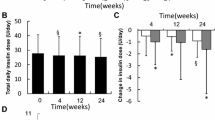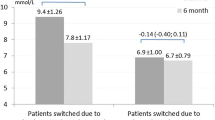Abstract
Aim
To compare the injection frequencies employed and the basal-to-total insulin dose ratios obtained when glargine (G) and detemir (D) are used in children with type 1 diabetes mellitus (T1DM) treated by basal–bolus therapy (BBT).
Methods
The study subjects consisted of 72 Japanese children and adolescents, including 40 males and 32 females, with T1DM. All patients were treated with BBT using rapid-acting insulin analogs such as aspart and lispro at each meal, and long-acting insulin analogs, including G and D, as the basal insulin preparation. We compared the daily injection frequencies and basal-to-total insulin dose ratios of G and D in children with T1DM.
Results
All 72 patients initially received a basal insulin analog, either G or D, once daily. At the time of the study, once-daily injection was continued in 47 (65.3%) patients, whereas it was necessary to switch the treatment to twice-daily injections in the remaining 25 (34.7%) patients. Among the patients who continued with once-daily injection, G was used in 39 patients (83.0%), and D in 8 patients (17.0%). Thus, G was used significantly more frequently for once-daily injection than D (P < 0.01). On the other hand, among the patients who switched to twice-daily injections, G was used in 9 patients (36.0%), and D in 16 patients (64.0%). Thus, D was used significantly more frequently than G for twice-daily injections (P < 0.01). Furthermore, the basal-to-total insulin dose ratio increased significantly when D was switched from once-daily to twice-daily injections (P < 0.05), whereas a significant increase in the ratio was not noted when G was switched in this manner.
Conclusions
G is used as a once-daily basal insulin regimen for children and adolescents with T1DM, whereas twice-daily dosing appears to be needed in the majority of patients treated with D. It might be necessary to increase the dosage of D by ~50% when switching from once-daily to twice-daily dosing in order to achieve optimal blood glucose control.
Similar content being viewed by others
References
Bangstad H-J, Danne T, Deeb LC, Jarosz-Chobot P, Urakami T, Hanas R. ISPAD Clinical Practice Consensus Guidelines 2009 Compendium. Insulin treatment in children and adolescents with diabetes. Pediatr Diabetes. 2009;10(Suppl 12):82–99.
Bolli GB, Di Marchi R, Park G, Pramming S, Koivisto VA. Insulin analogues and their potential in the management of diabetes. Diabetologia. 1999;42:1151–67.
Lepore M, Pampanelli S, Fanelli C, Porcellati F, Bartocci L, Di Vincenzo A, Cordoni C, Costa E, Brunetti P, Bolli GB. Pharmacokinetics and pharmacodynamics of the long-acting human insulin analog glargine, NPH insulin, and ultralente human insulin injected subcutaneously, and continuous subcutaneous infusion of insulin lispro. Diabetes. 2000;49:2142–8.
Heise T, Nosek L, Ronn BB, Endahl L, Heinemann L, Kapitza C, Draeger E. Lower within-subject variability of insulin detemir in comparison to NPH insulin and insulin glargine in people with type 1 diabetes. Diabetes. 2004;53:1614–20.
Geirich J, Becker RHA, Zhu R, Bolli GB. Fluctuation of serum basal insulin levels following single and multiple dosing of insulin glargine. Diabetes Technol Ther. 2006;8:237–43.
Porcellati F, Rossetti P, Busciantella NR, Marzotti S, Lucidi P, Luzio S, Owens DR, Bolli GB, Fanelli CG. Comparison of pharmacokinetics and dynamics of the long-acting insulin analogs glargine and detemir at steady state in type 1 diabetes. A double-blind, randomized, crossover study. Diabetes Care. 2007;30:2447–52.
Le Floch J-P, Levy M, Mosnier-Pudar H, Nobels F, Laroche S, Gonbert S, Eschwege E, Fontaine P, the Assessment of Detemir Administration in a Progressive Treat-to-Target Trial (ADAPT) Study Group. Comparison of once-versus twice-daily administration of insulin detemir, used with mealtime insulin aspart, in basal–bolus therapy for type 1 diabetes. Assessment of Detemir Administration in a Progressive Treat-to-Target Trial (ADAPT). Diabetes Care. 2009;32:32–7.
Ashwell SG, Gebbie J, Home PD. Twice-daily compared with once-daily glargine in people with type 1 diabetes using meal-time insulin aspart. Diabet Med. 2006;23:879–86.
Heinemann L, Linkeschowa R, Rave K, Hompesch B, Sedlack M, Heise T. Time-action profile of the long-acting insulin analog insulin glargine (HOE 901) in comparison with those of NPH insulin and placebo. Diabetes Care. 2000;23:644–9.
Ashwell SG, Gebbie J, Home PD. Optimal timing of injections of once-daily insulin glargine in people with type 1 diabetes using insulin lispro at meal-times. Diabet Med. 2006;23:46–52.
Robertson KJ, Shoenle E, Gucevt Z, Mordhorst L, Gall M-A, Ludvigsson J. Insulin detemir compared with NPH insulin in children and adolescents with type 1 diabetes. Diabet Med. 2007;24:27–34.
Urakami T, Moromoto S, Kubota S, Funaki S, Harada K. Usefulness of the long-acting insulin analogue glargine in basal–bolus therapy for Japanese children and adolescents with type 1 diabetes mellitus. J Pediatr Endocrinol Metab. 2007;20:807–15.
Home P, Bartley P, Russel-Jones D, Hanaire-Broutin H, Heeg JE, Abrams P, Landin-Olsson M, Hylleberg B, Lang H, Graeger E, Study to Evaluate the Administration of Detemir Insulin Efficacy, Safety, Stability (Steadiness) Study Group. Insulin detemir offers improved glycemic control compared with NPH insulin in people with type 1 diabetes: a randomized clinical trial. Diabetes Care. 2004;27:1081–7.
Pieber TR, Treichel HC, Hompesch B, Philotheou A, Mordhorst L, Gall MA, Robertson LI. Comparison of insulin detemir and insulin glargine in subjects with type 1 diabetes using intensive insulin therapy. Diabet Med. 2007;24:635–42.
Albright ES, Desmond R, Bell DS. Efficacy of conversion from bedtime NPH insulin injection to once- or twice-daily injections of insulin glargine in type 1 diabetic patients using basal/bolus therapy. Diabetes Care. 2004;27:632–3.
Robertson KJ, Shoenle E, Gucevt Z, Mordhorst L, Gall M-A, Ludvigsson J. Insulin detemir compared with NPH insulin in children and adolescents with type 1 diabetes. Diabet Med. 2007;24:27–34.
Garg SK, Gottlieb PA, Hisatomi ME, D’Souza A, Walker AJ, Izuora KE, Chase PH. Improved glycemic control without an increase in severe hypoglycemic episodes in intensively treated patients with type 1 diabetes receiving morning, evening, or split dose insulin glargine. Diabeted Res Clin Pract. 2004;66:49–56.
De Vries JH, Nattras M, Pieber TR. Refinding basal insulin therapy: what have we learned in the age of analogs? Diabetes Metab Res Rev. 2007;23:441–54.
Radziuk J, Pye S, Bradley B, Braaten J, Vignati L, Roach P, Bowsher R, DiMarchi R, Chance R. Basal activity profiles of NPH and [Nɛ-palmitoyl Lys (B29)] human insulins in subjects with IDDM. Diabetologia. 1998;41:116–20.
Owens DR, Bolli GB. Beyond the era of NPH insulin-long-acting insulin analogs: chemistry, comparative pharmacology, and clinical application. Diabet Tech Ther. 2008;10:333–49.
Hordern SV, Wright JE, Umpleby AM, Schojaee-Moradie F, Amiss J, Russel-Jones DL. Comparison of the effects on glucose and lipid metabolism of equipotent doses of insulin detmir and NPH insulin with a 16-h euglycemic clamp. Diabetologia. 2008;48:420–6.
Conflict of interest
None of the authors have any conflicts of interest to declare.
Author information
Authors and Affiliations
Corresponding author
About this article
Cite this article
Urakami, T., Kuwabara, R., Habu, M. et al. Comparison of the injection frequencies employed and basal-to-total insulin dose ratios obtained when glargine and detemir are used in children with type 1 diabetes mellitus treated by basal–bolus therapy. Diabetol Int 3, 75–79 (2012). https://doi.org/10.1007/s13340-011-0063-6
Received:
Accepted:
Published:
Issue Date:
DOI: https://doi.org/10.1007/s13340-011-0063-6




